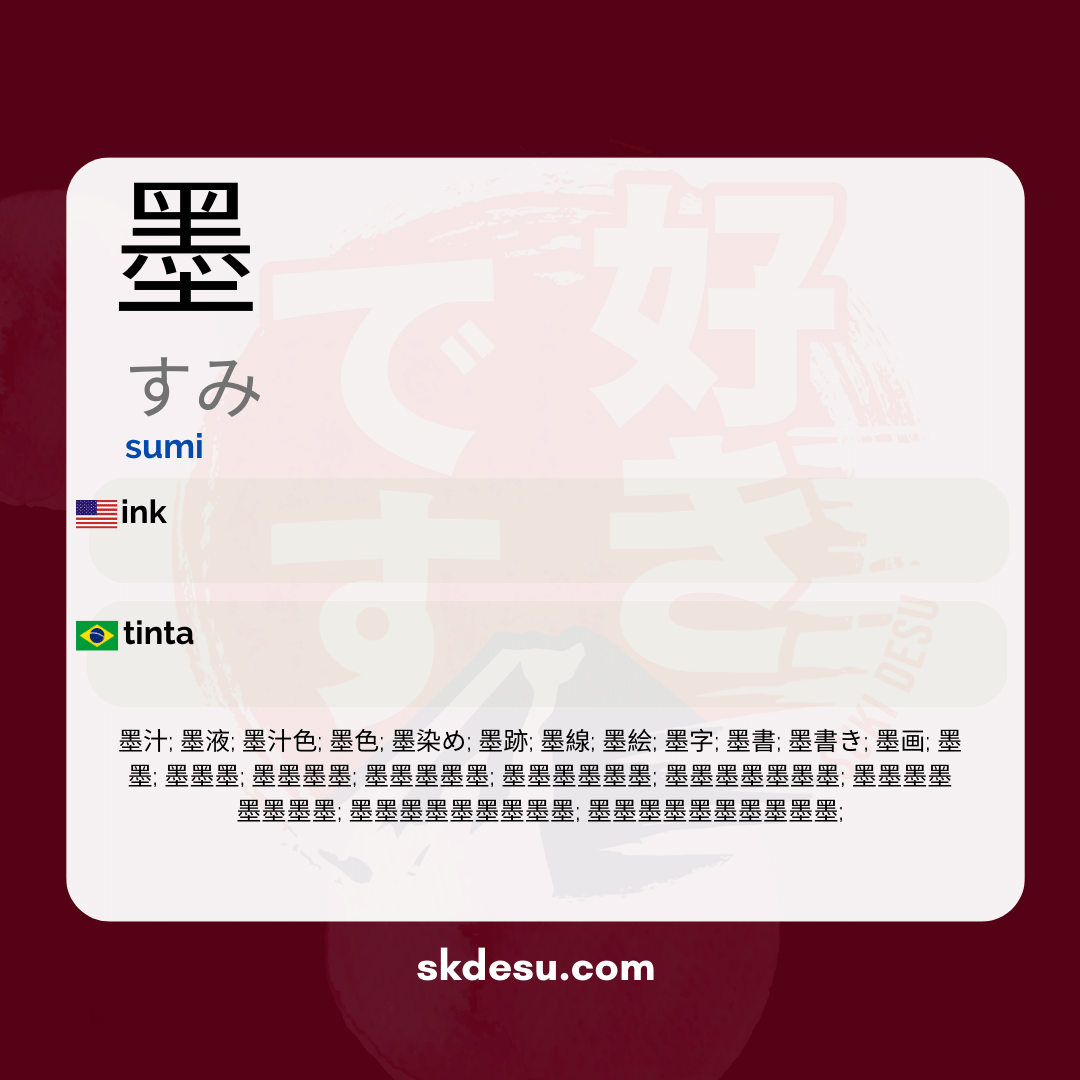Translation and Meaning of: 墨 - sumi
The Japanese word 墨[すみ] may seem simple at first glance, but it carries deep meanings and culturally interesting uses. If you are learning Japanese or just curious about the language, understanding this word goes beyond a simple translation. In this article, we will explore its meaning, origin, and how it is used in everyday Japanese, as well as tips for memorizing it effectively.
Sumi [墨] is a term that appears in various contexts, from traditional art to everyday expressions. If you've ever wondered what this word represents or how to use it correctly, keep reading to discover everything about it. Here at Suki Nihongo, our goal is to provide accurate and useful information for those who want to truly master Japanese.
Meaning and origin of 墨[すみ]
墨[すみ] means "ink" in Japanese, an essential material in calligraphy (書道) and sumi-e painting (墨絵). Its origin dates back to ancient China, where the ink was made from soot and animal glue, a technique that was adapted in Japan during the Nara period (710-794). The word itself is written with the kanji 墨, which combines the radicals for "earth" (土) and "black" (黒), reflecting its dark and earthy nature.
In addition to its literal meaning, 墨 can also symbolize something permanent or indelible, as the ink is known for its durability. This association appears in expressions like 墨に染まる (sumi ni somaru), which means "to be deeply influenced" by something, almost as if the ink impregnates the soul.
Cultural and everyday use
In Japan, 墨 is not limited to the artistic world. It is an integral part of ceremonies such as shodō (Japanese calligraphy), where the quality of the ink directly affects the final result. Artists value handmade 墨, which has color nuances and textures that are difficult to replicate with industrial inks. Even today, many masters insist on preparing their own ink by grinding the ink stick on a special stone (硯, suzuri).
Outside of the arts, the word appears in unexpected contexts. For example, 墨付き (sumitsuki) refers to official documents stamped with ink, indicating authenticity. In some regions, 墨 is also used metaphorically to describe very dark things, such as 墨のように黒い (sumi no you ni kuroi), "black as ink".
Tips for memorizing 墨[すみ]
An effective way to remember this word is to associate it with concrete images. Think of the kanji 墨 as a visual representation of dark ink flowing over paper. Another tip is to connect すみ to the sound of the word "smudge," as both involve dark marks. Repeating phrases like 墨で書く (sumi de kaku, "to write with ink") also helps to fix the vocabulary.
If you practice calligraphy or have an interest in Japanese art, try using 墨 in real contexts. Practical contact with the material facilitates memorization and deepens your cultural understanding. Remember that spaced repetition, like in flashcard apps, can be helpful for consolidating long-term learning.
Vocabulary
Expand your vocabulary with related words:
Synonyms and similar words
- 墨汁 (Bokujū) - Type of carbon-based ink used in calligraphy and painting.
- 墨液 (Bokueki) - Another term for coal-based ink, emphasizing its liquid form.
- 墨汁色 (Bokujūiro) - The color of black ink, related to the tone obtained from 墨汁.
- 墨色 (Sumi no iro) - Black color, especially the color obtained from charcoal ink.
- 墨染め (Sumizome) - Technique for dyeing fabrics with charcoal ink.
- 墨跡 (Bokuseki) - Marks left by charcoal ink, often referring to brushstroke calligraphy.
- 墨線 (Bokusen) - Lines made with charcoal ink, usually used in drawing and calligraphy.
- 墨絵 (Sumi-e) - Japanese-style painting made with charcoal ink, known for its subtlety.
- 墨字 (Bokuji) - Characters or letters written with charcoal ink.
- 墨書 (Bokushō) - Written with charcoal ink, often referring to traditional documents.
- 墨書き (Bokugaki) - Activity or technique of writing with charcoal ink.
- 墨画 (Sumi-e) - Comics or paintings made with black ink, which may be synonymous with 墨絵 depending on the context.
Romaji: sumi
Kana: すみ
Type: noun
L: jlpt-n2
Translation / Meaning: ink
Meaning in English: ink
Definition: A black pigment made of lacquer. Additionally, it is dissolved in water or vitreous sugar.
Quick Access
- Vocabulary
- Writing
- Sentences
How to Write in Japanese - (墨) sumi
See below a step-by-step guide on how to write the word by hand in Japanese. (墨) sumi:
Example Sentences - (墨) sumi
See below some example sentences:
Nenhum resultado encontrado.
Other Words of this Type: noun
See other words from our dictionary that are also: noun

